Physical Address
304 North Cardinal St.
Dorchester Center, MA 02124
Syndactyly is one of the most common congenital differences in the upper extremity. It can be classified as incomplete (soft tissue only, not extending to the tip), complete (soft tissue only, extending to the tip), complex (with distal bony union) or complicated (with more than only distal bone fusion). The timing of surgery depends on the fingers involved and the type of syndactyly. In simple digit 3–4 syndactyly there is no hurry, while in a hidden synpolydactyly, release is performed at an earlier stage. When bony fusion accompanies syndactyly (complex/complicated), these fusions should be separated early to prevent asymmetric growth if the fused fingers have different lengths. Creating a web, reconstructing a nailfold, and adding skin to the inner borders of the digits in complete syndactyly are three key elements in the separation of the involved digits.
Clinodactyly is derived from “ klineia ” (to bend, incline or slope) and “ dactylos ” (finger, toe). The term is used for a deviated finger in a radioulnar direction. The deviation is caused by an abnormally shaped bone. The middle phalanx of the little finger and the proximal phalanx of the thumb are the most frequently involved. Treatment can be a closed wedge osteotomy, reversed wedge osteotomy or an opening wedge osteotomy with or without bone graft, or a physiolysis in a bracketed epiphysis.
The Kirner deformity is a rare congenital difference of the hand, characterized by a volarly directed curvature of the distal phalanx of usually the little finger. Diagnosis is mostly made after an age of 5 years, and patients might be referred with “missed finger fracture”. Physical examination and radiographs will underscore the diagnosis with the volar curvature present as well as aberrant physis and diaphysis. Treatment is directed to an aesthetic rather than a functional improvement.
Apert syndrome (acrocephalosyndactyly) is characterized by craniosynostosis with complex acrosyndactyly of both hands and feet. Common features of the hands in Apert syndrome are: brachyclinodactyly of the thumb, complex syndactyly of index/long/ring finger, symbrachyphalangism, and simple syndactyly of the fourth web. Three different types of hand malformations can be recognized: the flat, “spade” hand (type I), the constricted cupped, “mitten” hand (type II), and the coalesced “rosebud” hand (type III).
The surgical goal in correction of Apert syndrome is correction of clinodactyly of the thumb, release of thumb and index or deepening of the first web, and separation of the fingers. If present, fourth–fifth finger metacarpal synostoses can be separated. The sequence of these corrections is dependent on the hand type and the experience of the surgeon.
Syndactyly is one of the most common congenital hand malformations, with an incidence of approximately 1 in 2000 to 3000 live births. Familial syndactyly is reported in 15–40% of syndactylies. It is more common in populations of European descent than in people from African descent. The inheritance pattern is believed to be autosomal dominant, with a variable penetrance and expression, but sporadic syndactyly occurs as well. About 50% of patients have bilateral involvement. Males are more affected than females, varying from 46% to 84% more. The web that is involved varies, as listed here: third web 50%; fourth web 30%; second web 15%, and first web 5%. It can appear isolated or in association with other deformities in the upper or lower extremity, or as part of a syndrome (such as Poland syndrome or Apert syndrome). Syndactyly can be associated with polydactyly and/or clefting (as in synpolydactyly, Greig syndrome, oculodentodigital syndrome, and cleft hand), and can be present in the radial fingers in ulnar longitudinal deficiency. In syndromes, the first web and second webs are more likely to be involved.
Syndactyly can be classified by clinical description or on an anatomical basis, or with a genetic and molecular approach. The most commonly used classification is divided as: incomplete (soft tissue only, not extending to the tip), complete (soft tissue only, extending to the tip), complex (with distal bone union) or complicated (with more than only distal bone fusion) ( Fig. 35.1 ). When only skin is involved, as in complete and incomplete syndactyly, the unfortunate term “simple” is used, although treatment of the cutaneous form is not necessarily simple. Complications during the primary operation might result in frequent revisions during growth.
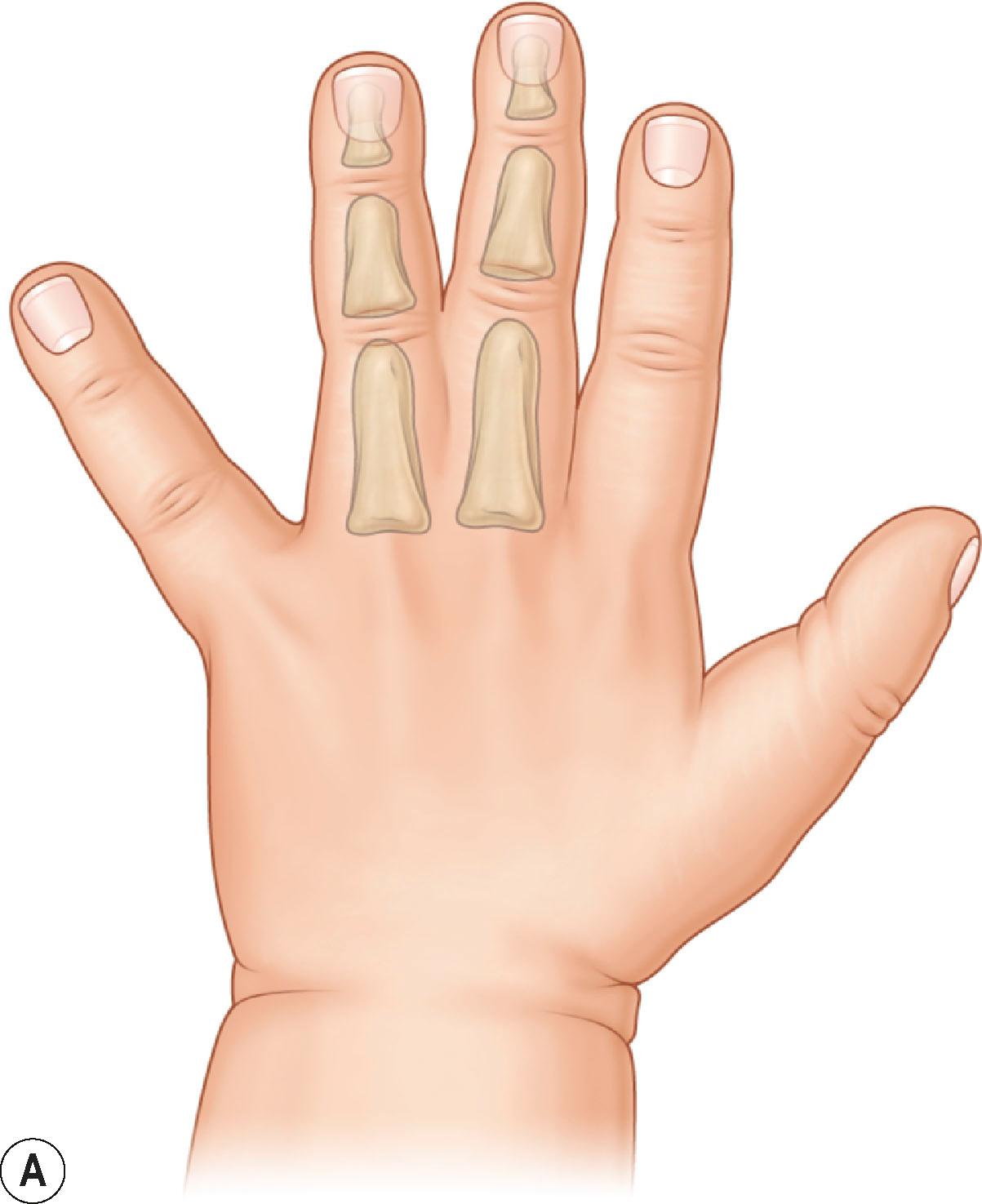
In the developing limb bud, fingers become apparent at day 41–43 and are fully separated at day 53. Apoptosis is needed for separation of the fingers. This process is mediated by BMP-4 (bone morphogenic protein) in a distal to proximal direction, thus explaining the clinical phenotypes. Current understanding relates these anomalies to differentiation disturbances in the developing hand plate.
Syndactyly can be present in a large variety of forms, as it is only a descriptive term. The fingers can be normal or anomalous; the number of affected fingers can differ, as well as the nature of involvement ( Fig. 35.2 ).
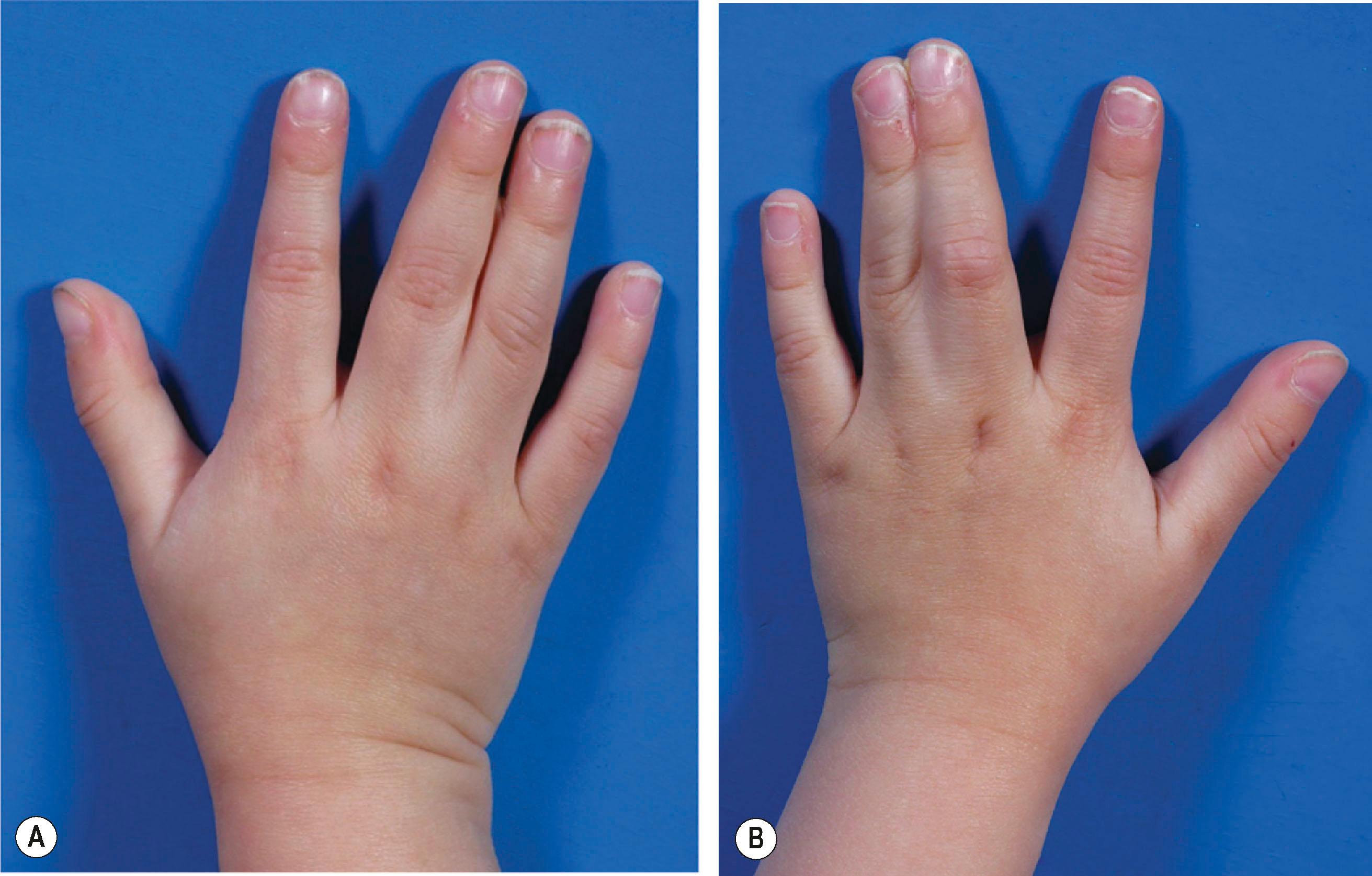
In the patient with cutaneous syndactyly, only the soft tissues between the fingers are attached. These skin bridges can vary from supple/wide to tight, influencing the flap possibilities during surgery, and warranting the possible necessity for skin grafting. In the incomplete form, the distal boundary usually ends just before the proximal interphalangeal joint (PIPJ). In complete syndactyly, the nails can range from separated with full pulps of the affected fingers (see Fig. 35.2 ) to conjoined nails with ridges and insufficient pulp for either side ( Fig. 35.3 ). If the involved fingers have normally developed phalanges, the joints and tendons are mostly normal. If not, like in symbrachydactyly, the tendons and joints might be affected as well. Neurovascular bundles might bifurcate more distally, forcing the surgeon to choose. When fingers are of unequal length, the longest finger will tend to bend and rotate more during growth especially if the distal ends are fused.
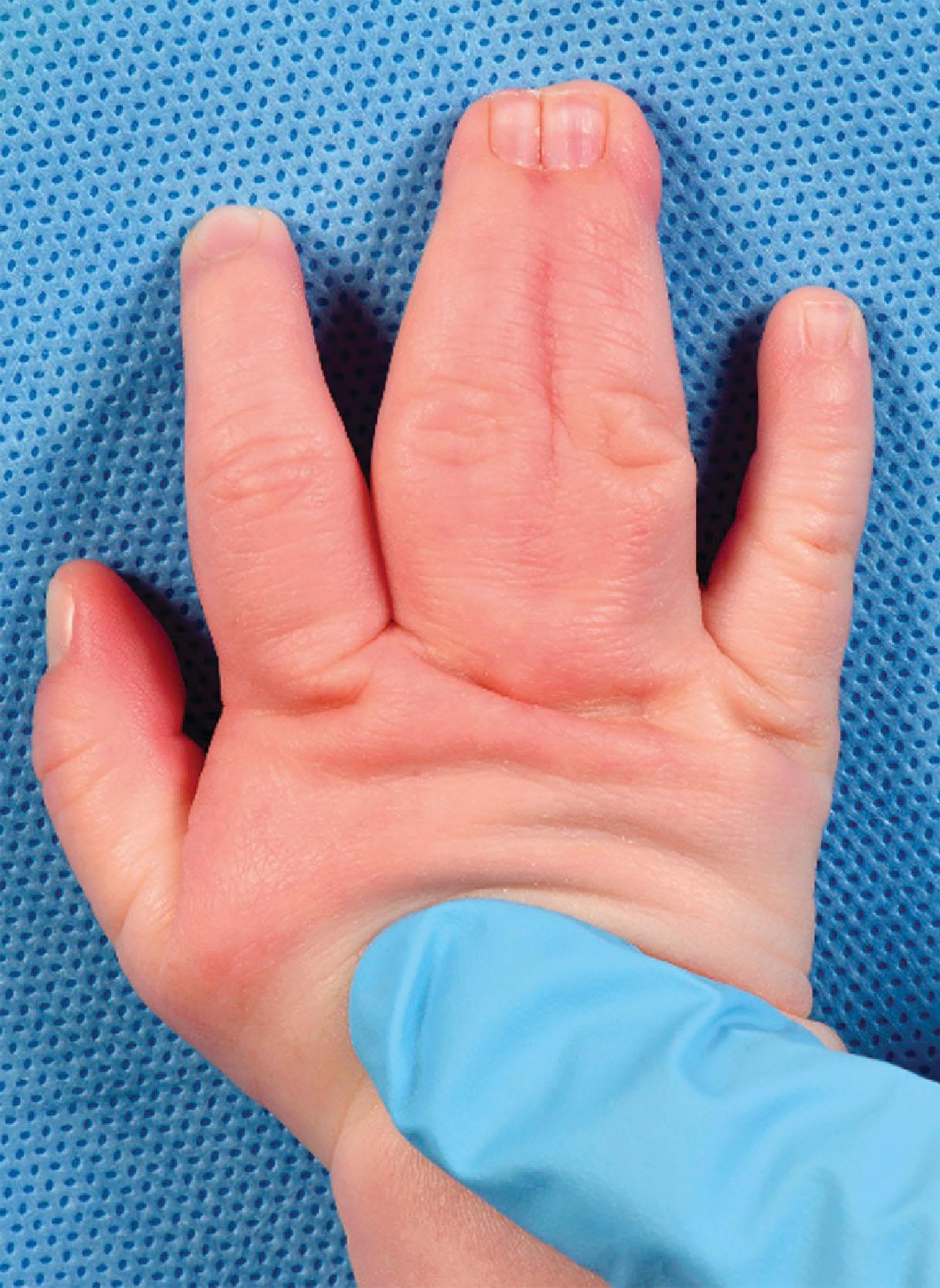
Complex syndactyly with distal bone fusion involving only two fingers can be recognized by a tapered distal end with inward rotation of the fingers and abnormally ridged or confluent nails ( Fig. 35.4 ). When more fingers are distally fused, they can be flat to very cupped with anomalous nails, abnormal bones with different lengths, and abnormally located, and with insufficiently developed or undeveloped joints.
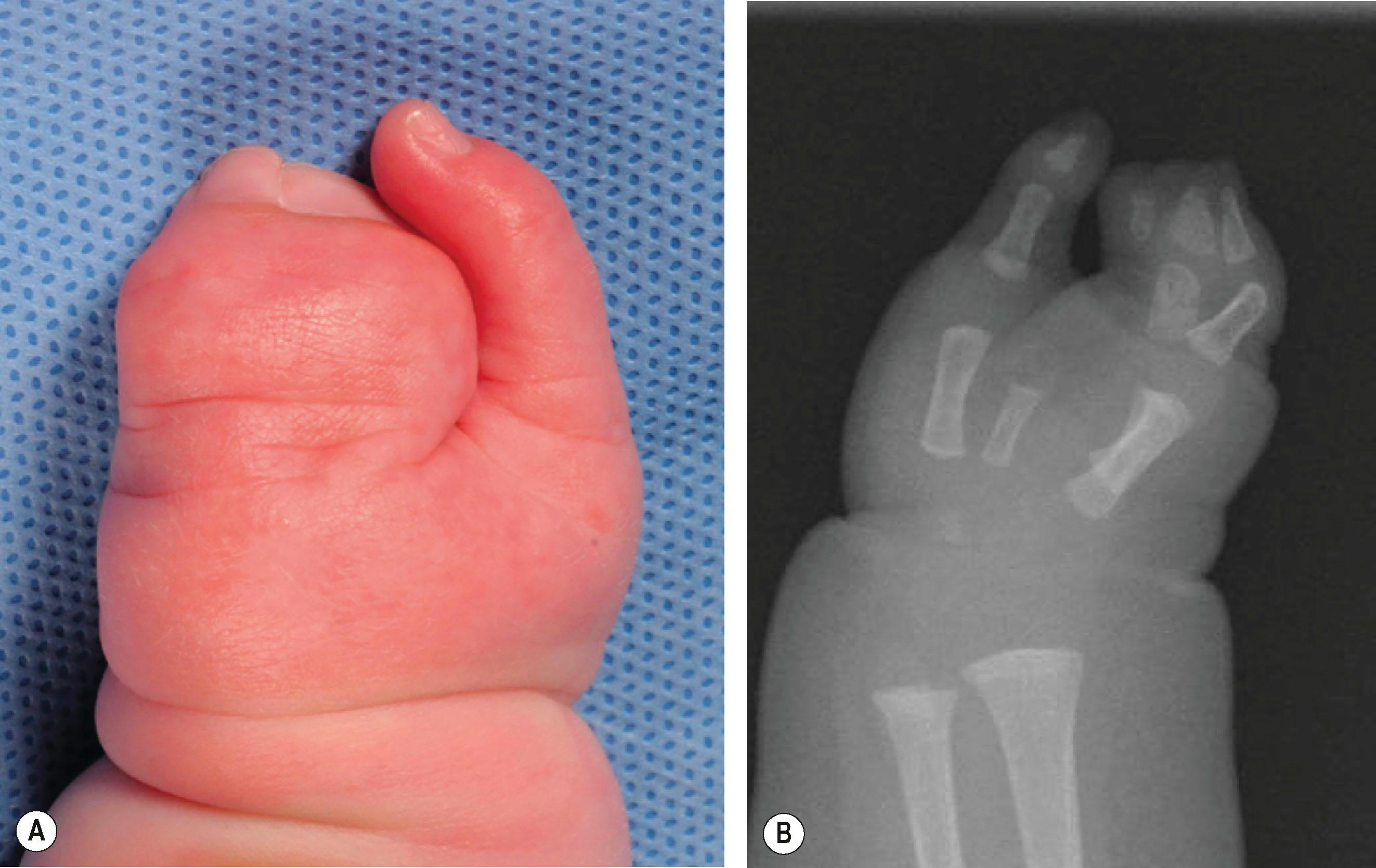
Complicated syndactyly is characterized by an abnormal bone structure inside the syndactyly with fusions, rudimentary bones, missing bones, abnormal joints, and sometimes crossed bones.
In most patients, except for the very mild incomplete syndactylies, surgical treatment is indicated, and with regard to syndactyly, the question rather is when and how. Timing of treatment is controversial in pediatric hand surgery. The primary goal of the operation is improvement of hand function, and with that in mind, the operative treatment could be postponed until no adverse effects on hand function and motor development are to be expected.
Early indications for surgery are syndactylies between fingers of unequal length; and/or distal bone fusions; and in complex or complicated acrosyndactyly, especially if the thumb is involved. These early indications are to prevent asymmetric growth and/or to create a possibility to grasp when the first web is involved. The release can be performed from 6 months onward, especially when multiple webs and two hands are involved. In the simple third web syndactyly, an operation can be safely delayed until an age of 18 months.
Some advantages of postponing surgery until 18 months of age are a safer anesthesia, decrease of subcutaneous fat allowing easier mobilization of the skin flaps, and a larger hand with less risk of web creep (the hand doubles in size in the first 3 years of life). Contraindications for surgery might be a syndactyly with fully fused phalanges, or with support of only one metacarpal bone (“super digit”). If surgical separation is possible, it might result in deviation of the fingers and insufficient motion. In complicated syndactylies, the anatomical support for the individual fingers is often not enough to have them function sufficiently following separation.
Careful assessment of the maturity of each individual finger is necessary before release of syndactyly is undertaken. The choice to separate can be extremely difficult, especially in symbrachydactyly and synpolydactyly. The biggest challenge is to convince parents or children, who often request to separate these fingers.
The goal of syndactyly treatment is to create as normal a webspace as possible at the right level in which the separated fingers are allowed normal movement. Treatment of syndactyly should not only address the key points of adequate release but also in the least number of operations while minimizing complications.
Release of syndactyly requires separation of conjoined skin and subcutaneous tissue preserving integrity of the neurovascular bundles. Furthermore, coalesced Cleland and Grayson ligaments and existing sites of osseous union are divided. On the dorsal side, subcutaneous fat can be removed, but care has to be taken to prevent damage to the neurovascular bundles when defatting volar flaps. The lateral digital flaps should be designed in a zigzag fashion to avoid longitudinal scar contracture.
For safety reasons, two adjacent complete syndactylous fingers are not separated at the same time as vascular anatomy can be different, and skin flaps may be limited. In short multiple syndactylous fingers, for instance, dominant digital vessels may only exist on the lateral sides of the conjoined fingers. Sometimes it is necessary to sacrifice one of the vessels in a distal bifurcation. The nerves in these cases can mostly be dissected more proximally. In young children, bone or cartilaginous fusions can be separated by knife or osteotome. Care should be taken to remove a possible hidden polydactyly. Especially in cases where the 4th web is involved, a polydactylous distal phalanx and/or remnant of the middle phalanx may be present ( Fig. 35.5 ).
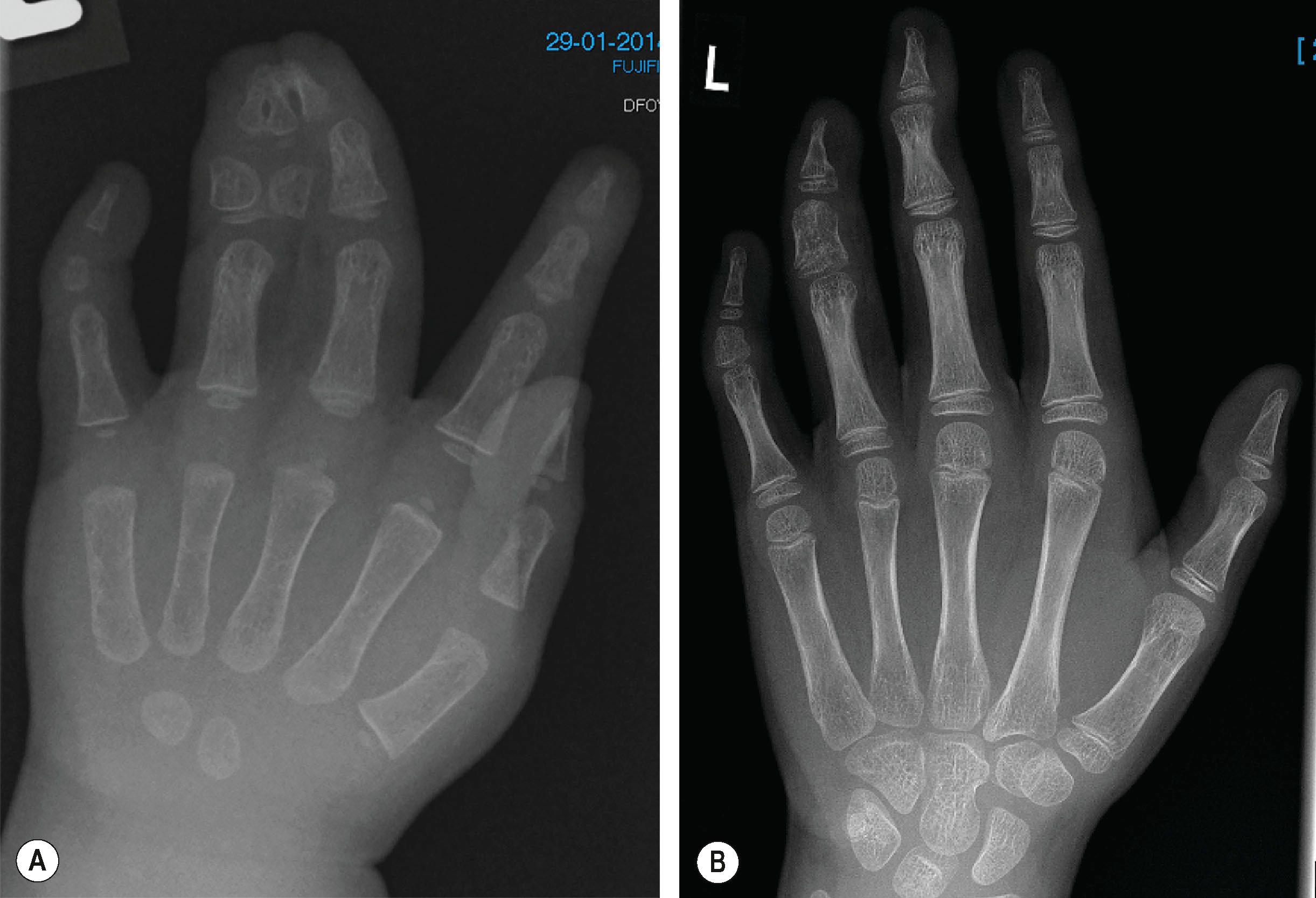
The web in syndactyly can basically be created by a dorsal flap, a palmar flap or a combination of both. These techniques had already been practiced in the second half of the nineteenth century and are still used today. To these techniques have been added flaps with slightly different design or flaps more proximal from the dorsum of the hand. The author’s preference is for a large dorsal flap because the wings will cover partly the lateral side of the proximal phalanx, and the tip is interdigitated on the palmar side, thus preventing linear scars in the web itself as well as on the palmar side. In an effort to prevent skin grafts, dorsal metacarpal flaps have been used to create the web, followed by primary closure of the fingers. However, these techniques leave a conspicuous scar on the dorsal side of the hand.
To prevent web creep in the future, a dorsal flap is used that will cover the newly made web without scars that might interfere during growth. In addition, the appearance of the hand is important. Visible skin grafts on the dorsal hand, that will darken in time, are experienced as aesthetically less pleasing by patients. Therefore, a flap is chosen that will allow for primary closure on the dorsal hand and fingers with the skin grafts at the midlateral sides of the fingers, if grafts are needed at all ( Figs. 35.6 & 35.7 ).
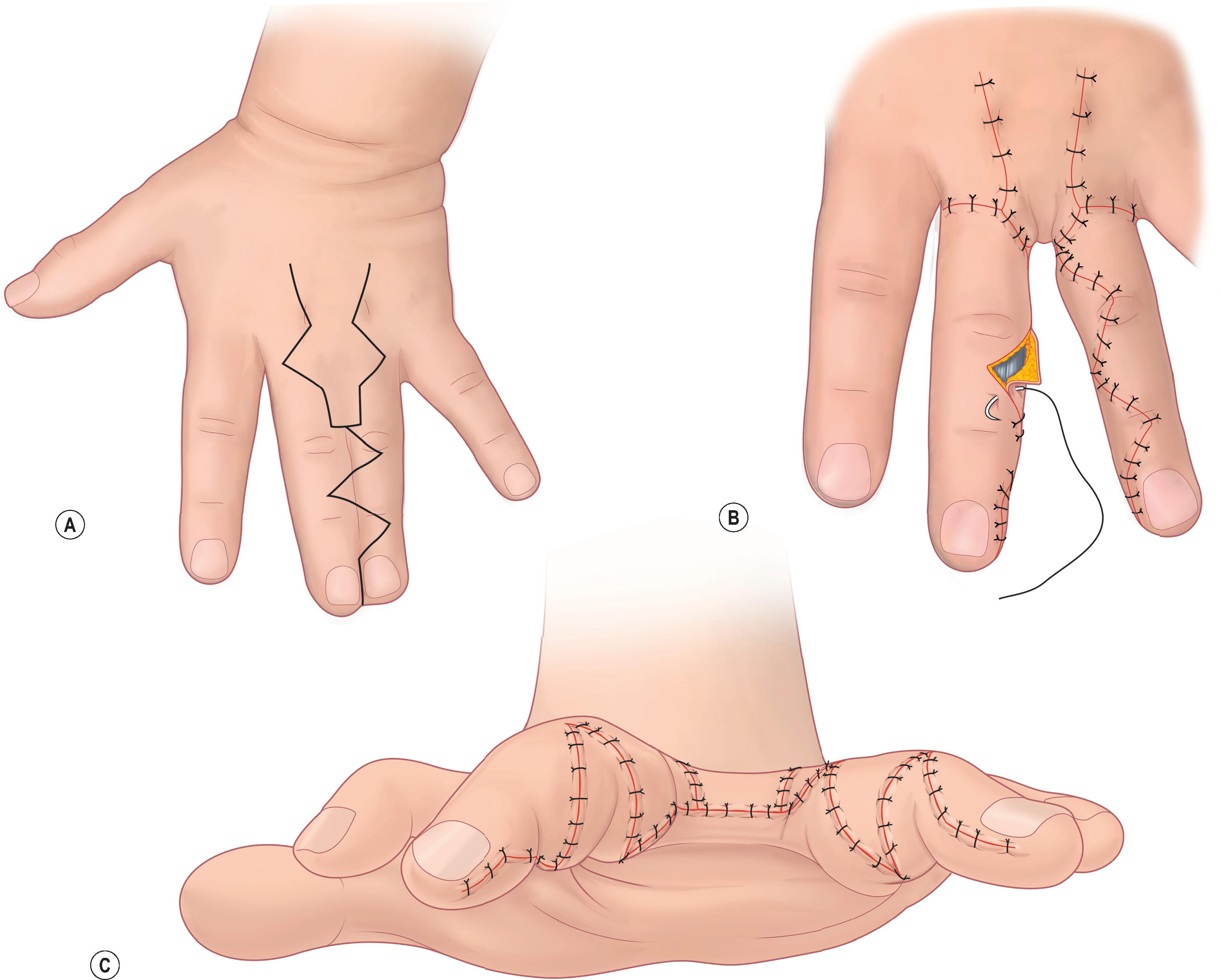
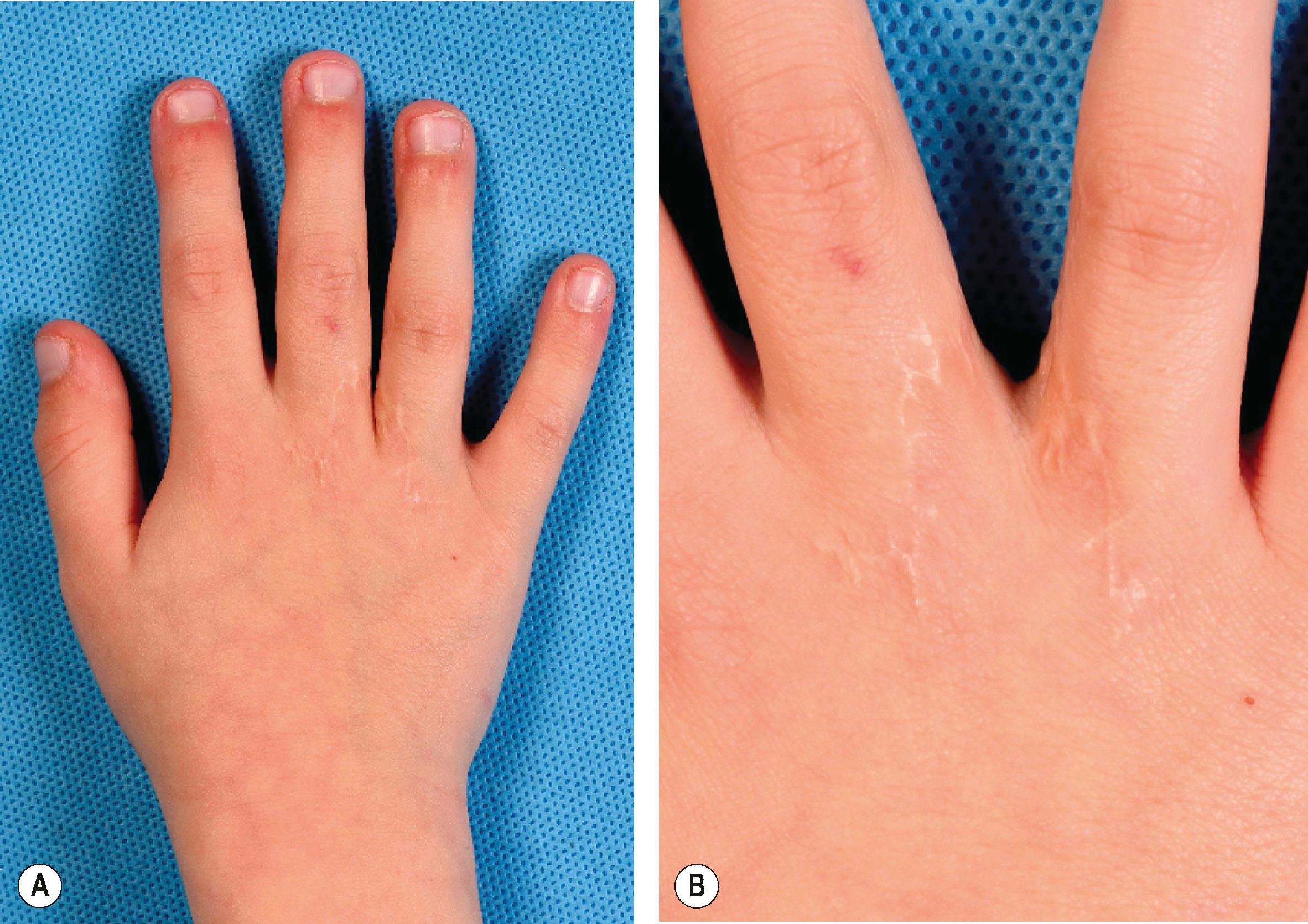
For the first web, different kinds of Z-flaps (four-flap, double, double-opposing, five-flap) or transposition flaps from the dorsum of the hand and index or thumb are used depending on the width and depth of the created defect following release. Also, pedicled flaps and free flaps have been proposed for the larger defects. In the first web, the release of the tight fascia on the first dorsal interosseous muscle in combination with the fascia on the adductor muscle is essential to create a deeper web. Sometimes even the insertion of the adductor muscle is shifted more proximally to open the web. Upton has published an excellent overview of all the different flaps for web reconstruction. For incomplete syndactyly, many variations of rotating Z-flaps have been described for web reconstruction.
In syndactyly, the shortage of skin is very often underestimated. In the regular simple syndactyly, skin shortage is at least 36% of the circumference of the finger which is separated. Cronin has popularized the zigzag skin separation distal to the flap for web reconstruction. The created triangular flaps provide coverage at the proximal interphalangeal joint. The triangular flaps can either be fully or partially interdigitated depending on the extent of the skin shortage. In this way, the areas for skin grafting can be diminished and placed on less demanding parts of the fingers. Full-thickness skin grafts (FTSG) are mostly used to cover the defects (see Fig. 35.6 ). The donor site for skin grafts is traditionally the groin. However, this skin will be more pigmented in time and may grow hair after puberty. Therefore, our preferred donor sites are the elbow or wrist crease, as these scars will diminish over time. A longitudinal scar on the volar side of the lower arm, or at the level of the hypothenar area, will give aesthetically unpleasing scars. If a large area needs to be grafted, as in multiple involved webs, or Apert’s hands, the skin in the abdominal skin crease can be harvested extensively over and over, with a scar that will be covered by underwear or swimwear.
If the nails are separately developed in complete syndactyly, the pulp can be separated and the skin advanced to the rim. If the nails are partly fused with a deep furrow and indentation on the pulp side, then simple separation and primary closure is often still possible. If the nails are conjoined, with minimal ridges, nail wall reconstruction with flaps might be necessary. Buck-Gramcko has introduced the pedicled pulp flaps for nail wall reconstruction from the adjacent finger pulp. The disadvantage of these flaps is the flattened aspect of the fingertips and involved lateral borders. Alternatives include the use of a thenar flap, but this has the disadvantage that the finger has to be supple to reach the thenar easily and it is a two-stage procedure. The defects on the lateral fingertips may alternatively be covered by a FTSG, with an insufficient synonychial reconstruction as a result.
With rounded fingertips as a goal and inspired by the secondary healing in fingertip injuries, the author now leaves the syndactylized sides of the fingers open for secondary healing, with esthetically pleasing results and no synonychial complications ( Fig. 35.8 ).
When performing a syndactyly release, my personal approach is not limited to a fixed sequence with regard to dissection of the flaps and neurovascular bundle. But there are some key features I would like to share. If you are a beginner, take your time; your patient needs it. The desyndactylization part is the shorter part of the operation, but after identifying the bifurcation of the digital artery, the closing of the flaps takes time. Take your time and “find the Zen” of closing the flaps and placing the full-thickness skin grafts.
Choose a flap dorsally (see Fig. 35.6 ) that will not give scars in the web.
Draw the middle of the finger dorsally, this will help with positioning the wings of the flap.
Identify the middle of the metacarpal heads.
The distal part of the flap is at two-thirds to three-quarters of the length of the proximal phalanx.
Use big zigzag flaps, the small ones might become full-thickness skin grafts.
Draw lines from the tip of the zigzag to the opposite side, perpendicular to the axis of the finger. This will help in locating the tip of the zigzag on the volar side of the opposite finger.
Mark the volar little V flap more proximal than the location of the actual web.
Start the incision dorsally and elevate the flaps.
The bifurcation of the dorsal vein is a giveaway for the level of the digital artery bifurcation.
Dissect from distal to proximal on the dorsal side, leaving the volar skin intact.
Dissect the arterial bifurcation from the dorsal side; it is easier!
When there is a big discrepancy in finger length, adjust your drawings on the volar side if needed.
Defat only the dorsal skin if necessary. Particularly in synpolydactyly, extra fat is present.
Start closing by approximating the middle of the dorsal flap to the tip of the volar V flap. In that way, the arterial bifurcation is protected.
Finally, take your time with skin grafting. All the time spent will contribute to the ultimate result.
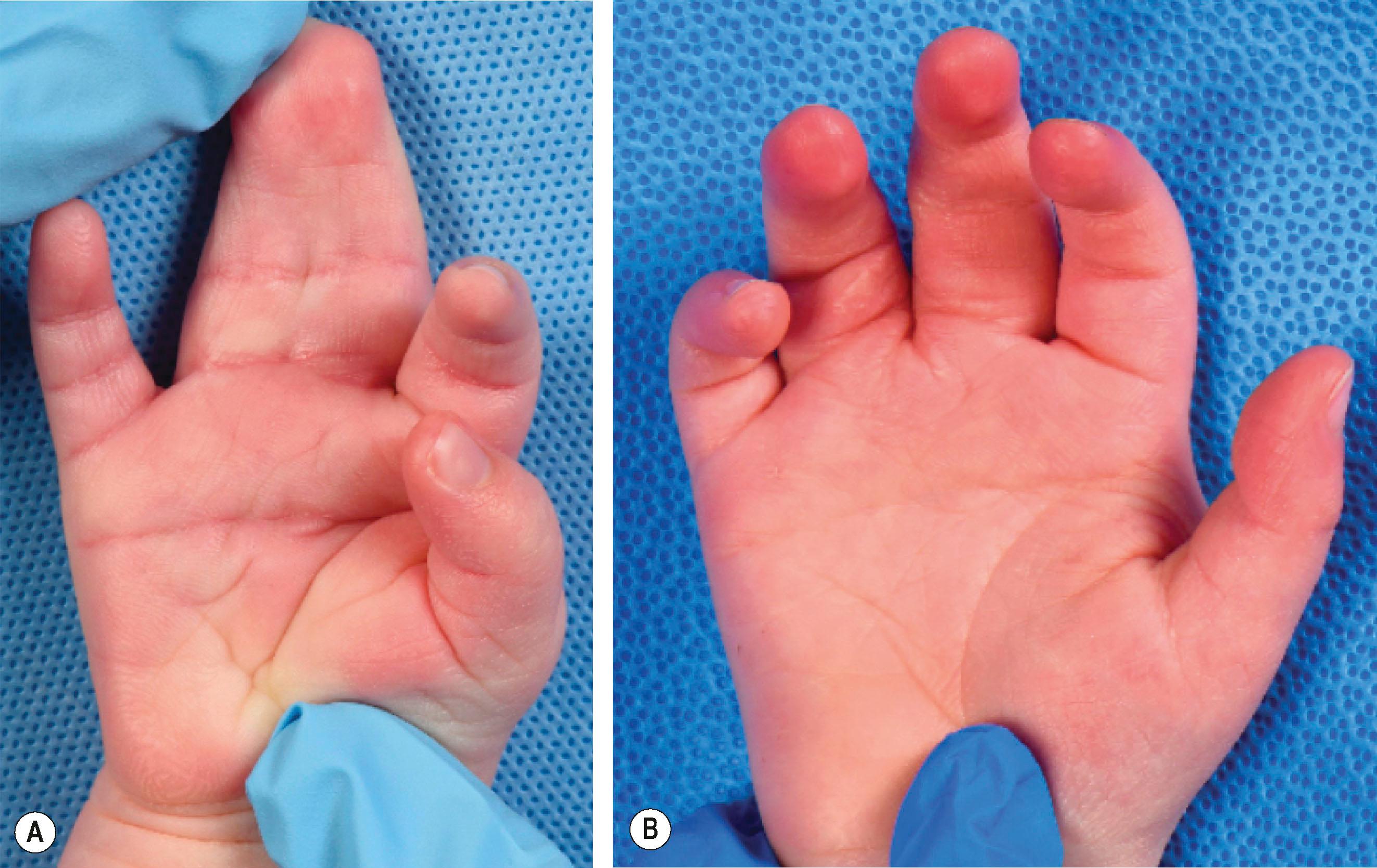
Paraffin gauze is applied on the wounds and grafts, followed by moist dressings creating a wedge between the involved fingers, then synthetic cotton, and an elastic bandage. It is very important to prevent the wedge from dislocating. This might give skin bridging in the web with a synechia as a result. The elbow, forearm, and hand are subsequently covered with a longitudinal adhesive bandage to prevent removing the dressing ( Fig. 35.9 ). It is important to position the elbow at 90° flexion.
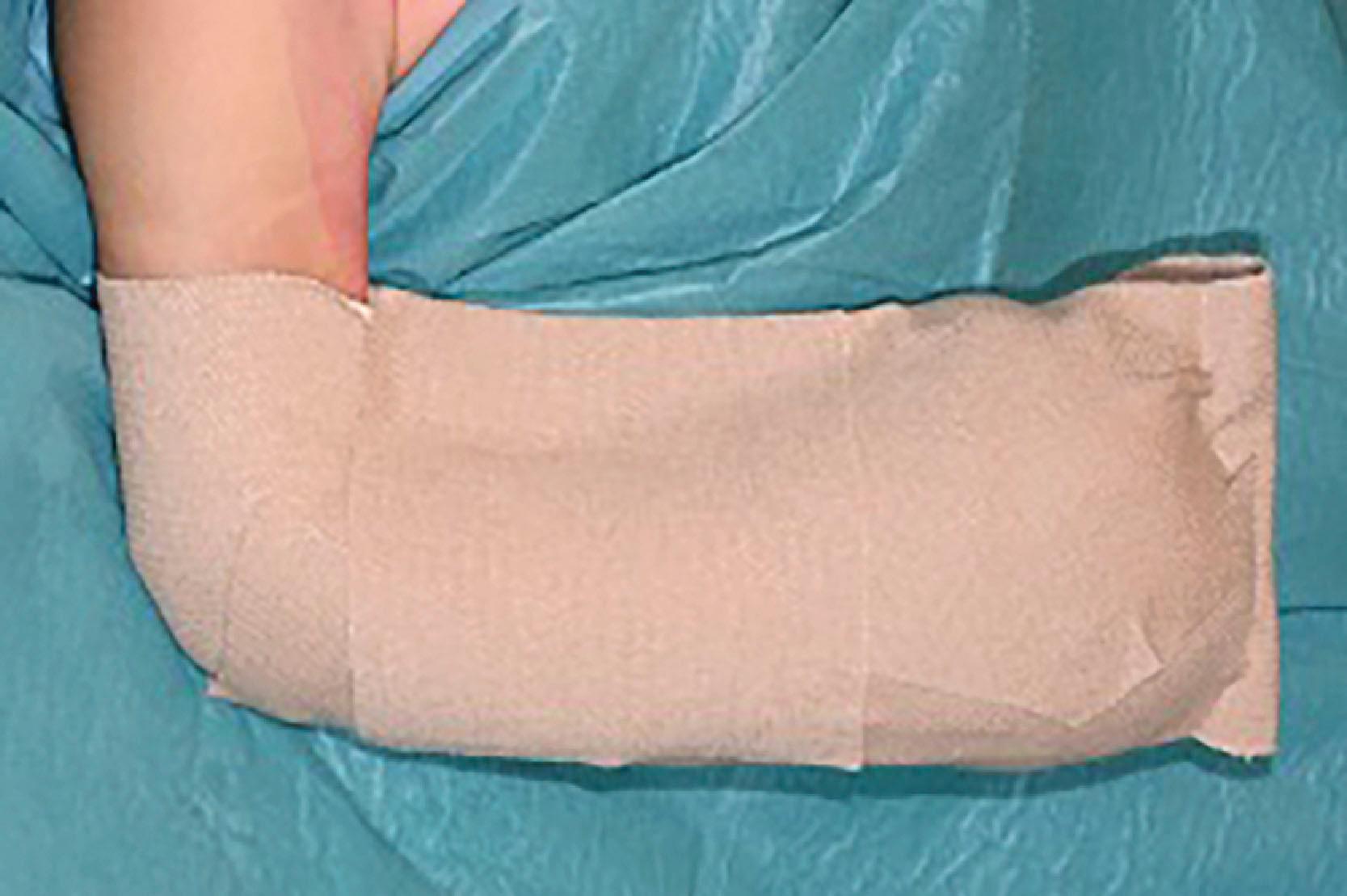
The general concept among most authors is to perform wound inspection in the first 2 weeks after operation. . However, for the past 5 years, we have introduced a 6-week period of initial dressing and immobilization with less complications and workload for the doctor, and more importantly, for the parents. Only one direct postoperative outpatient clinic contact is needed before starting hand therapy (if necessary). Further immobilization is dependent on surgery for associated malformations.
In complex syndactyly, with a tight synostosis between both distal phalanges, a rotation and deviation of the fingers can be present. In most cases, this will resolve after the child has trained the intrinsics that have not been used before the desyndactylization. A minor distal rotation will still be present, but the deviation will resolve. It is important to explain this to the parents with regard to managing expectations.
The desyndactylization has a low complication rate in general, with only 0.3% directly related complications in a cohort of 2047 patients. Early complications include graft loss, flap necrosis, infection, or even complete adhesion of the fingers. The latter is mostly due to postoperative infection or insufficient application of a postoperative bandage.
Web creep is the migration of the web more distally during growth and has been reported to be from 0% to 12% depending on the used techniques, the long-term follow-up, and the variety of included patients. Reoperations have been performed for web creep in up to 8% of patients. Factors influencing web creep include complex syndactyly, inadequate flap design, the use of split-thickness skin grafts (STSGs), secondary healing after graft loss, and infection.
With regard to skin grafts, while FTSGs have a better skin quality than STSGs, they can also create problems such as graft loss, skin contracture, web creep, hair growth, hyperpigmentation, and hypertrophic scarring. Skin contractures from using STSGs are reported to occur in 40%, while this was only 22% when using FTSGs. Flexion contractures are reported in a series with long-term follow-up to be 13% and rotation and lateral deviation in 12%. Hair growth when using FTSGs from the groin is reported as being 71%. Leaving small areas open between numerous triangular flaps seems to result in less scarring and there is no difference in web creep versus the classical approach.
Very rarely, patients will develop a hypertrophic or keloid scar after a syndactyly reconstruction ( Fig. 35.10 ). An incidence of 0.7% (8 patients) has been reported with primary digital enlargement as a risk factor (7 out of 8 patients). Treatment with pressure, corticosteroids, and re-excision was unsuccessful in 8 patients. Two patients treated with methotrexate adjunct to surgery had a near normal healing. More recently, intralesional bleomycin has been used with promising results. Fortunately, this functionally and aesthetically limiting complication is very rare. As a result, specific literature on treating keloids after syndactyly release is very sparse.
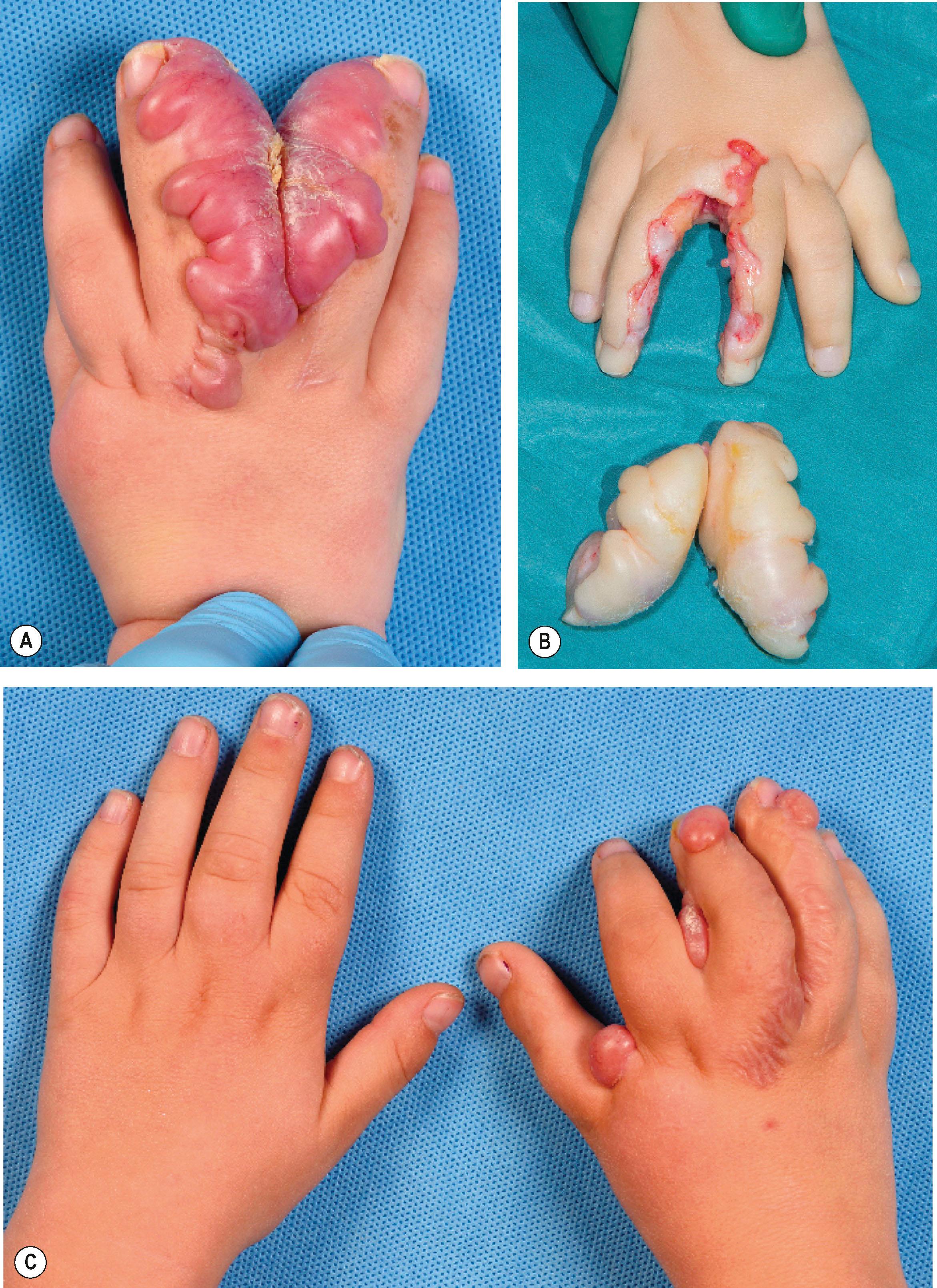
In a group treated with dorsal metacarpal flaps or extended dorsal interdigital flaps and primary closure, results were better, avoiding all the problems with skin grafts. However, in a systematic review comparing skin graft techniques with dorsal metacarpal flaps, no superior outcomes could be attributed to the different techniques. In our opinion, the scar on the dorsal side of the hand is aesthetically displeasing (see Fig. 35.11B ).
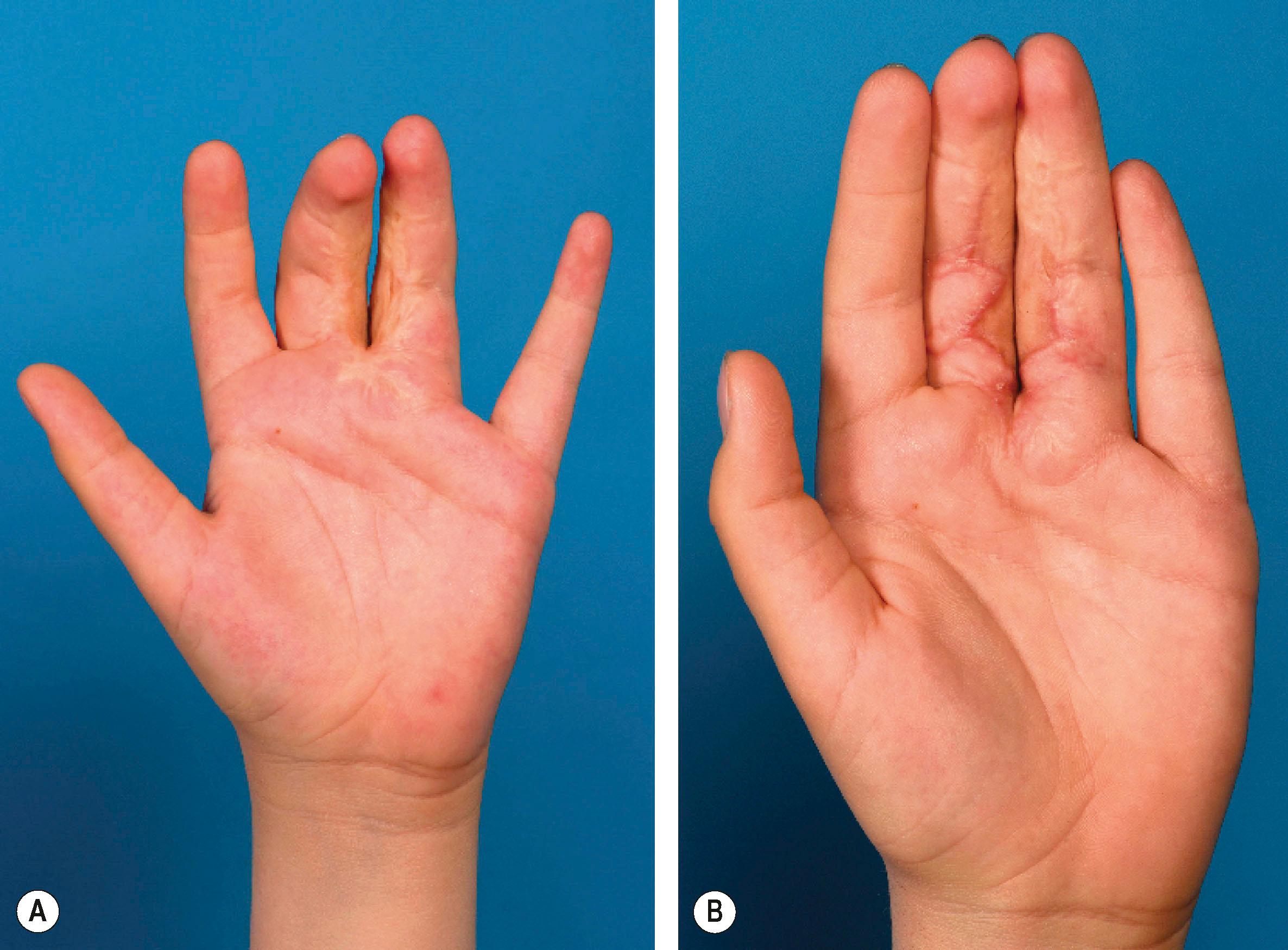
In complex and complicated syndactylies following separation, rotated and deviated fingers can occur as well as insufficient functioning of the individual separated fingers. Joint instabilities are also possible and may be underestimated. This is especially true for the polysyndactylies. The joint contracture therefore is a consequence of the initial deformity and difficult to treat.
Patients should be followed until the end of growth to detect later problems, such as web creep, scar contractures ( Fig. 35.11 ), and bony deviations due to different types of delta phalanges. Revision of residual syndactyly is often undertaken, especially at the first web in more complex cases.
Scar contracture release and re-deepening of webs with or without flaps may be necessary in cases of symbrachydactyly or synpolydactyly, which are not able to extend their involved fingers actively, probably due to an aberrant anatomy of the intrinsic muscles (see Fig. 35.11 ). In complicated syndactylies, for instance polysyndactyly, ligament reconstructions, osteotomies, chondrodesis and arthrodeses may be necessary. These operations are tailored to anatomical differences, active and passive function, and most importantly, the patient’s wishes.
Become a Clinical Tree membership for Full access and enjoy Unlimited articles
If you are a member. Log in here